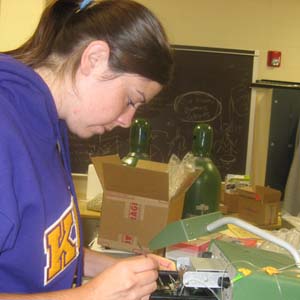

Venture Boldly

Office of Communications
2 East South Street
Galesburg, IL 61401

 The basement lab in the Sharvy G. Umbeck Science and Math Center where Catherine Ray '08 is spending her summer is crowded with gadgets, oxygen tanks, a water maze, and a cluster of white and black boxes resting prominently on a table.
The basement lab in the Sharvy G. Umbeck Science and Math Center where Catherine Ray '08 is spending her summer is crowded with gadgets, oxygen tanks, a water maze, and a cluster of white and black boxes resting prominently on a table.
Her voice perks up at the mention of research, labs, and rats. As a researcher, Ray is conducting experiments in hopes of providing information that has not been done on the prenatal effects of methamphetamine exposure. "There have been a lot of studies about alcohol and cocaine addiction and stimulants in general,? Ray says. ?But, none on methamphetamines."
Ray worked in a center for the developmentally disabled in her home state of New Mexico. While there, she worked on a fetal alcohol project and became interested in prenatal exposure to drugs. Ray followed that experience with another in a neonatal ward in Texas, where she saw babies born addicted to drugs. Her experiences led to a Richter funded senior research project that she started this summer.
Her work begins with impregnating rats. "My rats need to be to term of what equals the third trimester of a human pregnancy," she says.
Once to term, the control rats are injected with a saline solution while the other group is injected with methamphetamines. Once the babies are born, Ray has to waits another 20 days. "I need them to simulate adolescence."
The rats are then divided into two groups. The first group is involved in behavior experiments. In the first experiment, the rats are to find a clear plastic platform within a water-filled tank that they can climb onto. "Rats really hate water," Ray says. This experiment repeats over six days. "By the last day they really know how to find that platform fast."
Ray observes the rats and looks for marked learning differences between the rats that had prenatal exposure to methamphetamines and those that didn't. "At this stage, we need more rats to complete the study," she says.
The second half of the behavior study involves putting the rats in a white or black box. The boxes are connected by a door. Over the course of eight days, Ray administers methamphetamines when the rats are placed in the white box and saline solution when they are in the black box. On the ninth day, the rats are allowed to select which box they prefer. "The only behavior of note is the meth rats are hyper sensitive. Although the rats really did not have a preference to either box, the prenatal meth rats could not stay in one box for too long before they lost their attention and moved on to the other box," Ray says.
The two behavior tests specifically study the hippocampus section of the rats' brain. The hippocampus relates to learning and memory. "With the water maze, we can assume the rats are using the hippocampus to find the platform."
In the second group of rats in Ray's study, the brain tissue in the rats that had prenatal exposure to the methamphetamines is examined for lasting changes in the hippocampus. By conducting neurological testing, Ray is looking for actual and not assumed data about the hippocampus.
If the experiment works, the tissue responds to stimulation by an electrode. However, Ray points out that working with the tissue is tricky. "The samples can be torn or burned. The electrophysiology data we have is finicky. The electrodes have to be put in just the right places on the tissue," she says. "Control is really hard. The more animals we have, the more credible the data."
In recording the data, Ray varies the amount of electrode stimulation and looks for trends in the data that corroborates the theory that the hippocampus stimulates learning and memory.
"Whether or not we come out with our expectations or something different, the info that I provide will help someone else build on this research," she says.
Ray will spend the fall term in Copenhagen Denmark. While there, she will study medical practice and policy programs and learn about socialized medicine while working in a hospital. She will get back to her project when she returns and collects, analyzes, and publishes her work.
Ray says she has always planned on attending medical school, and while at Knox she wanted to get as much research experience as she could get.
"When I came to Knox, I was self motivated, but I didn't realize the types of opportunities you can create for yourself," she says. "Knox gives back what you put into it. I have been able to create quite an amazing experience at Knox based on the flexibility and trust the school has in its students."
Ray also says that the relationship she has formed with her professors has contributed to her experiences. "They are not just friends, but mentors. I learn a lot from them. I genuinely appreciate their opinions. I really like that about Knox."
Catherine Ray plans on attending medical school after she graduates from Knox in 2008.Published on July 30, 2007